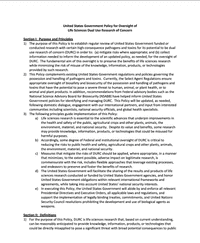United States Government Policy for Oversight of Life Sciences Dual Use Research of Concern
[March 2012 DURC Policy]
This policy establishes regular review of United States Government funded or conducted research with high-consequence pathogens and toxins for its potential to be dual use research of concern (DURC) in order to: (a) mitigate risks where appropriate; and (b) develop of an updated policy, as needed. The fundamental aim of this oversight is to preserve the benefits of life sciences research while minimizing the risk of misuse of the knowledge, information, products, or technologies provided by such research.
SUMMARY
This document establishes a regular review of research funded or conducted by the U.S. government with certain high-consequence pathogens and toxins to establish whether they have potential to be dual use research of concern (DURC). The goal of this policy is to mitigate risks as appropriate and to collect information needed to update this policy for the oversight of DURC as needed. This policy covers research involving one or more of 15 agents or toxins listed in Section III.1 based on their ability to pose the greatest risk of deliberate misuse, or any of 7 research methods that could increase the harmfulness of the agent or toxin as described in Section III.2. Released on March 29, 2012, this policy is openly available as an English language PDF.
This policy outlines the responsibility of all U.S. federal departments and agencies that conduct or fund life sciences research, including the review of projects, assessing the risk and benefits of any projects that meet the DURC definition, and developing risk mitigation plans with researchers. It also outlines reporting requirements for agencies, including biannual reports on their project assessments and risk mitigation plans submitted to the Assistant to the President for Homeland Security and Counterterrorism. As necessary and appropriate, the U.S. Government will continue to consult with the NSABB, in compliance with the provisions of the Federal Advisory Committee Act, or convene the Countering Biological Threats Interagency Policy Committee for guidance on mitigating DURC risks.


..png)
